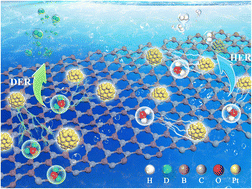B4C enhances the supported platinum DER/HER performance†
Abstract
The high energy barrier of D–O bond breakage leads to a slow kinetic reaction rate in the electrocatalytic deuterium evolution reaction (DER). Therefore, the platinum–carbon catalyst (Pt/C) shows unsatisfactory performance in the DER. Here, Pt/B4C catalysts were constructed via the strong metal support interaction (SMSI) between boron carbide (B4C) and platinum (Pt). The SMSI influenced the electronic structure and dispersion of Pt, resulting in a higher degree of Pt dispersion on B4C with stronger electronegativity, and Pt/B4C thus exhibited better DER/HER performance than Pt/C in acidic and basic solutions. The overpotential was only 48 mV (11 mV) and 47 mV (31 mV) when the current density was 10 mA cm−2 in 1 M NaOD (NaOH) and 0.5 M D2SO4 (H2SO4), respectively. The Pt/B4C catalyst activity showed no decay after accelerated durability testing (ADT) and 100 hours of i–t stability testing. Density functional theory (DFT) suggests that the electron rearrangement between B4C and metallic Pt leads to a stronger electronegativity of Pt, whereas the electron-deficient state of Pt can facilitate the dissociation of D2O/H2O and the resolution of D2/H2. This research provides a useful new guideline and reference for the preparation of high-performance DER/HER catalysts.

- This article is part of the themed collection: Journal of Materials Chemistry A HOT Papers


 Please wait while we load your content...
Please wait while we load your content...